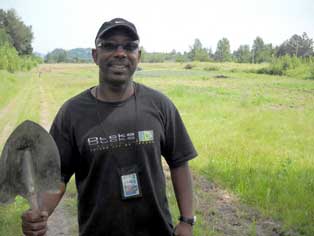 ST. LOUIS (AP) -- An Illinois farmer made so much money this year he made loan payments on one tractor a year in advance and exchanged some older ones for newer models. An Iowa farmer upgraded his combine and also paid off debt, while an elderly Oregon farmer poured into retirement funds a bundle of his $2 million take from a well-timed sale of much of his turf and equipment.
ST. LOUIS (AP) -- An Illinois farmer made so much money this year he made loan payments on one tractor a year in advance and exchanged some older ones for newer models. An Iowa farmer upgraded his combine and also paid off debt, while an elderly Oregon farmer poured into retirement funds a bundle of his $2 million take from a well-timed sale of much of his turf and equipment.
While much of America worries about the possibility of a double-dip recession, such stories of prosperity are cropping up as U.S. farmers enjoy their best run in decades, thanks to high prices for many crops, livestock and farmland and strong global demand for corn used in making ethanol.
Farm profits are expected to spike by 28 percent this year to $100.9 billion, and the amount of cash farms have available to pay bills also is expected to top $100 billion - the first time both measures have done so, according to the U.S. Department of Agriculture. All the while, crop sales are expected to pass the $200 billion mark for the first time in U.S. history, and double-digit increases are expected in livestock sales.
"We're just experiencing the best of times," said Bruce Johnson, an agricultural economist at the University of Nebraska in Lincoln. "It's a story to tell."
That's not to say that everyone is sharing in the good fortune. Near Gardner, Kan., a short drive south of Kansas City, a lack of rain and nagging winds conspired to leave Bill Voigts with about half of the soybeans he expected. His harvest of corn was worse, coming in at about one-third of his normal production. Even with insurance, he didn't quite break even on the 2,400 acres he farms - most of them rented.
"Had it not been for insurance in his area, it'd be a disaster. That's the only thing that saves us," said Voigts, 66.
But he noted that the drought plaguing farmers like him helped drive up prices for commodities like corn, soybeans and wheat, benefitting those fortunate enough to get a good crop.
"At the expense of some farmers, other farmers become wealthy," he said. "That's really the whole story. That's not the government's fault, it's nobody's fault. That's just the way things happen.
"Some people got left behind."
Yet most of the talk about U.S. farming remains bullish, with analysts widely trumpeting "the new normal" in U.S. agriculture: Demand in China, India and other developing countries for U.S. agricultural exports - and hunger for corn for ethanol - has been keeping prices high and farming profitable.
In central Illinois' Morgan County near Jacksonville, Dale Hadden says he was "pleasantly surprised" by the corn and soybeans he got from the some 4,000 acres he works with his brother and their parents, considering they lost about 400 acres of corn to 21 inches of rain in June.
All told, Hadden estimated his crops were worth 10 percent to 15 percent more than in previous years, amounting to tens of thousands of dollars. He spent a chunk of that on an advance full-year payment on a seven-year loan on one of his tractors and to pay down debt on land.
Much of the rest he cautiously set aside.
"It was a successful year," said Hadden, a 38-year-old with two children, ages 11 and 9. "But most farmers would tell you that just because you're flush with cash, you don't spend it all."
In Oregon, 79-year-old Warren Haught sure didn't. With four decades of farming under his belt, Haught - socked by the high cost of electricity to irrigate crops in high desert country - unloaded his 1,500-acre operation a couple of years ago. He pocketed $1.7 million on the land sale and $300,000 from liquidating everything from haying equipment to plows and tractors, using some of proceeds on two new homes - one of him, the other for his son and his family - while saving much of the rest.
"It was a pretty good deal at the time," said Haught, who now has just 72 acres near mountainous Klamath Falls on which he grows alfalfa and grass crops. He'd like to get at least 100 more acres, saying demand for hay in China and other Pacific Rim countries is boosting prices.
"It was kind of the perfect storm - what you had this year brought a good price," he said. "Everything seemed to be a good price."
In western Iowa near Kingsley, Jeff Reinking and his brother - partners in a 2,500-acre operation evenly split between corn and beans - recently traded in a 2006 combine for one three years newer - spoils from what Reinking called "the best year for me." He also paid off some debt and put some money aside in case things aren't always so rosy.
"I guess we're getting the better end of things right now," Reinking said. "That has not always been the case."
© 2011 The Associated Press. All rights reserved. This material may not be published, broadcast, rewritten or redistributed. Learn more about our Privacy Policy and Terms of Use.
Portland and Seattle
Free Subscription to Breaking News
Free Subscription to Breaking News



















































































































































































































































































































































